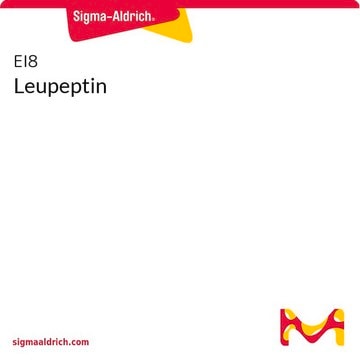205531
CA-074 Me
≥98% (HPLC), solid, Cathepsin B inhibitor, Calbiochem®
Synonym(s):
CA-074 Me, Cathepsin B Inhibitor IV, [L-3- trans-(Propylcarbamoyl)oxirane-2-carbonyl]-L-isoleucyl-L-proline Methyl Ester
About This Item
Recommended Products
product name
CA-074 Me, CA-074 Me, CAS 147859-80-1, is a cell-permeable analog of CA-074 that acts as an irreversible inhibitor of intracellular cathepsin B.
Quality Level
Assay
≥98% (HPLC)
form
solid
manufacturer/tradename
Calbiochem®
storage condition
OK to freeze
color
white
solubility
DMSO: 10 mg/mL
shipped in
ambient
storage temp.
−20°C
General description
Biochem/physiol Actions
cathepsin B
Warning
Reconstitution
Other Notes
Authier, F., et al. 1999. J. Biol. Chem.274, 33723.
Hill, P.A., et al. 1994. J. Cell Biochem. 56, 118.
Buttle, D.J., et al. 1992. Arch. Biochem. Biophys. 299, 377.
Legal Information
Storage Class Code
11 - Combustible Solids
WGK
WGK 3
Flash Point(F)
Not applicable
Flash Point(C)
Not applicable
Certificates of Analysis (COA)
Search for Certificates of Analysis (COA) by entering the products Lot/Batch Number. Lot and Batch Numbers can be found on a product’s label following the words ‘Lot’ or ‘Batch’.
Already Own This Product?
Find documentation for the products that you have recently purchased in the Document Library.
Our team of scientists has experience in all areas of research including Life Science, Material Science, Chemical Synthesis, Chromatography, Analytical and many others.
Contact Technical Service








